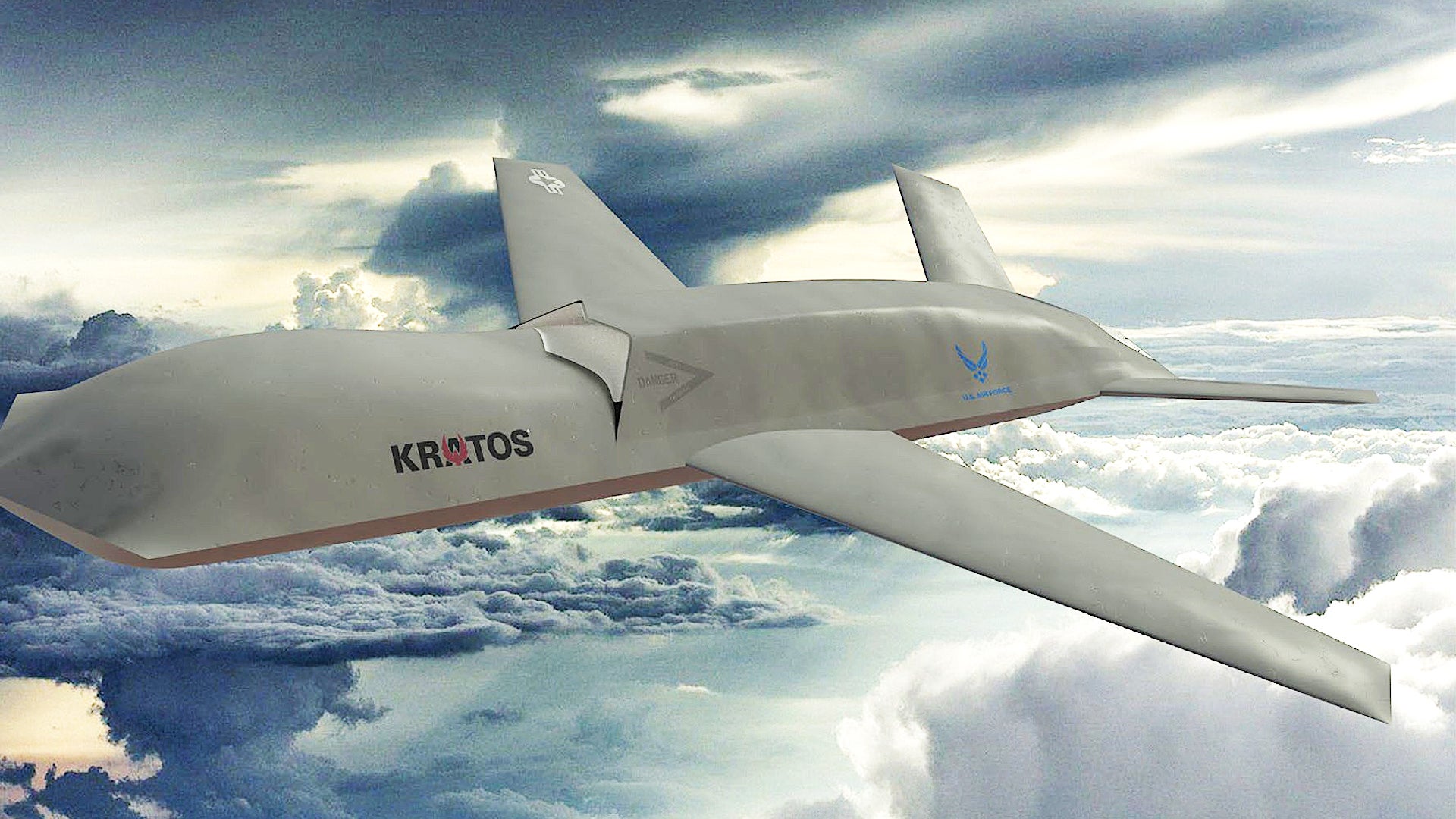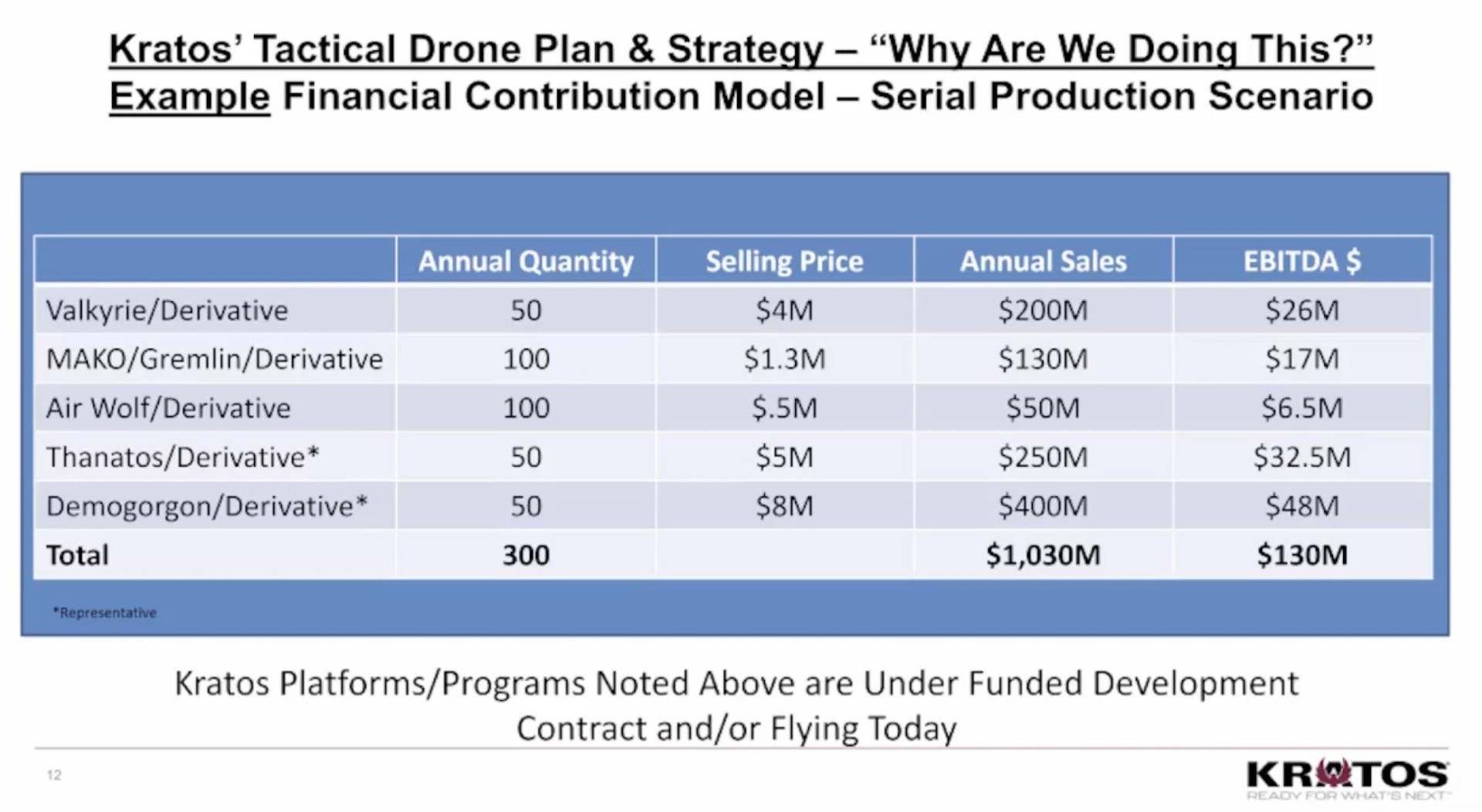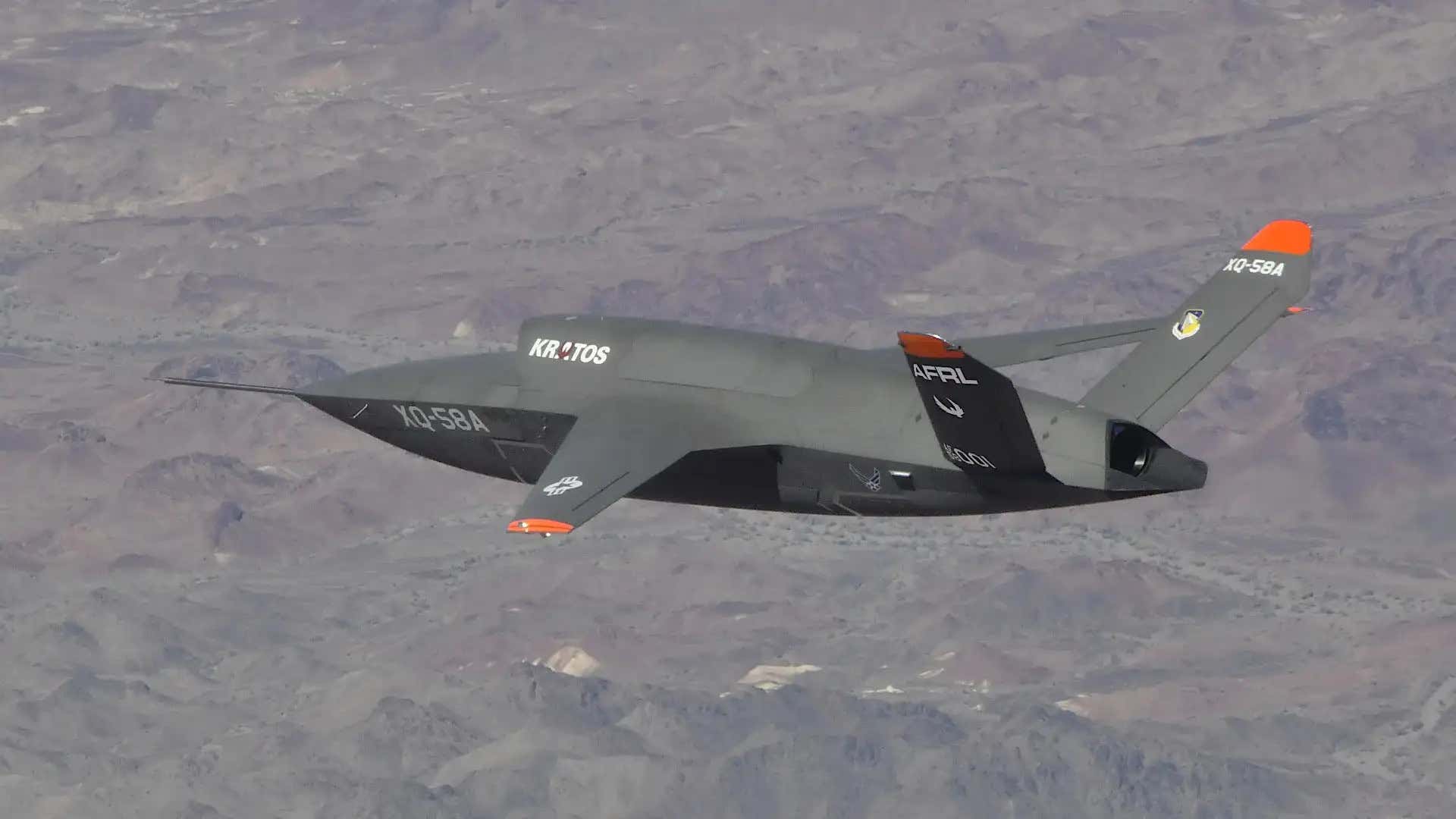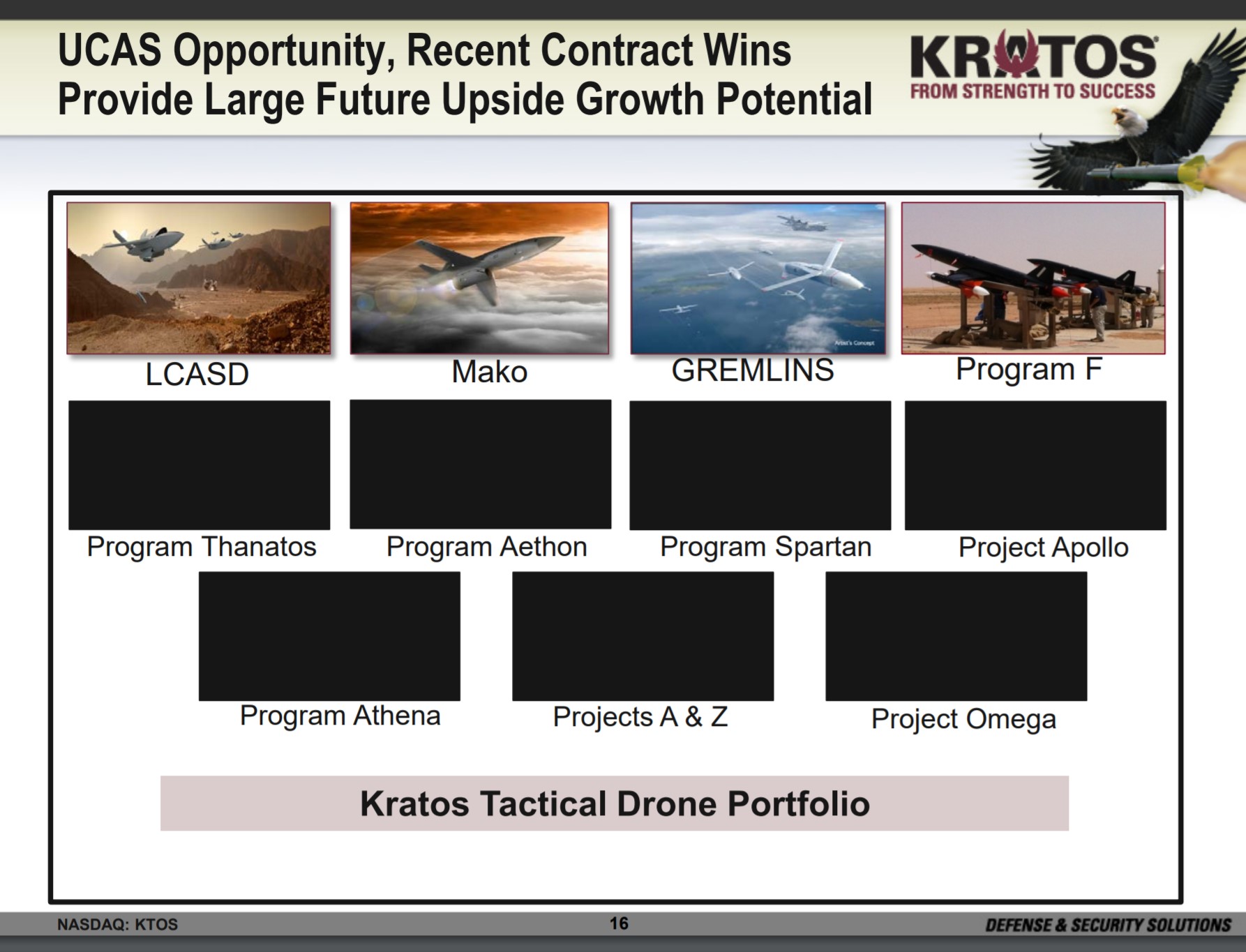Kratos has revealed the existence of a new drone program known as ‘Demogorgon.’ While there are no additional details about this new unmanned aerial vehicle platform aside from its name and projected production price, the acknowledgment of the Demogorgon program comes shortly after Kratos released the first rendering of the U.S. Air Force’s shadowy Off-Board Sensing Station program, or OBSS.
The slide released as part of an investor brief is the first known mention of the Demogorgon program. It states that the Demogorgon drone will have a production price of $8 million a unit with a projected annual production run of 50, potentially bringing in $400 million in annual sales. The slide includes several other Kratos drone programs including the XQ-58 Valkyrie, the air-launched Gremlin, UTAP-22 Mako, the Air Wolf “tactical” drone, and two programs not yet revealed to the public: Thanatos and Demogorgon. The name “Thanatos” has previously appeared in Kratos publications, although there are no further additional details about the program.

The Demogorgon drone is listed as having an $8 million unit price, making it by far the most expensive “tactical” drone listed on this Kratos slide with a price tag twice as high as the Valkyrie. This would seem to point to a higher degree of complexity than the XQ-58, which the Air Force Research Laboratory described as “game changing” and was designed to integrate with fourth and fifth-generation manned aircraft.

Interestingly, the slide mentioning Demogorgon groups the Kratos Gremlin and Mako drone together under the same heading and unit cost of $1.3 million. The Gremlin has been described as a swarming drone that can be deployed and recovered in mid-air by a mothership while the Mako, designated UTAP-22, is based on the company’s BQM-167 target drone and is aimed at fulfilling a “loyal wingman” role alongside manned aircraft. It’s unclear why the two are grouped in this slide shown to Kratos investors. One possibility is that Gremlin does not refer to the reusable air-launched and recovered research and development effort but is another configuration of the UTAP-22.

The name of the newly-acknowledged program, ‘Demogorgon,’ has been in use for centuries and refers broadly to demons or deities associated with the underworld or occult. While the term is used widely throughout fantasy literature and role-playing games, the mythological creature popped up on the pop culture radar when it appeared in the first season of Netflix’s hit science fiction series Stranger Things.
Mythological origins aside, it’s possible that Demogorgon is an internal name for Kratos’ “transformational” OBSS program. The company released a rendering of the new drone late last year, revealing a stealthy design with a simple swept wing and wide-splayed v-tail. The company has released no details about the UAV’s expected performance or capabilities, but Steve Fendley, the President of Kratos’s Unmanned Systems Division, told Breaking Defense in a carefully-worded statement that “there’s certainly the possibility of having an attritable aircraft carry an exquisite sensor” in response to a question about possible OBSS payloads. “For example, we could integrate a $5 million-$10 million sensor on one of our systems. But that specific tail number, in all likelihood, would not be performing an attritable mission, even though technically the expensive sensor would be on an attritable aircraft.”

“Attritable” platforms are generally defined as being low-cost enough to function in higher-threat environments where the risk of losing assets is high. In his interview with Breaking Defense, Kratos’ Fendley defines these systems as “a high-performance-versus-cost-system solution that the user can afford to potentially lose at some non-zero rate.” He then describes how these might fit into a larger concept of operations:
The other thing about attritables that’s different from legacy UAS, outfitted with their exquisite sensors, is distributed lethality in the case of weapons and distributed sensing in the case of sensor missions. Maybe you have a very comprehensive sensor capability because you have 10 of these attritable aircraft carrying non-exquisite EO/IR systems, for example. You’re fusing the data you get from those aircraft remotely, and the picture you get is very precise. Now let’s say that three of those aircraft get shot down; you still have a very high-quality picture and good intelligence because you have a seven-sensor baseline instead of just one very expensive sensor. The distributed method helps reduce cost and increase mission effectiveness and survivability.”
An October 2021 Kratos press release describes OBSS as “an affordable, highly modular conventional takeoff and landing jet-powered UAS” that could augment missions by carrying additional sensors or firepower, which could serve as a force multiplier alongside manned assets:
The Kratos OBSS solution incorporates innovative manufacturing techniques that enhance its ability not only to provide significant performance for sensor extension missions for manned jet aircraft, but also will accommodate significant offensive weapons volume to also act as a weapons bay extension for manned aircraft. OBSS is a new addition to the Kratos family of low-cost Autonomous Collaborative Platforms (ACP) designed to employ weapons, sensors, and other effects that generate affordable, force multiplier combat power with a forward force posture.
It’s impossible to fully predict in which mission sets the OBSS could potentially function, although, given the descriptions of its likely capabilities, the drones could serve as distributed sensor networks and aid in locating and targeting a range of threats. At least one Kratos UTAP-22 drone has been seen equipped with an infrared search and track (IRST) sensor system capable of stealthily detecting targets without being countered by radar-absorbing, deflecting, or jamming technologies. The only concept art of OBSS is clipped off in the front, with what appears to be a fairing for an IRST-like sensor. This would make the most sense as using drones equipped with IRSTs for counter-air missions is being tested at scale now and is prominently featured in the Air Force’s ongoing Skyborg AI-infused unmanned technology initiative. Other sensors, such as low-cost AESA radars could also possibly be payloads for OBSS.
Aside from the shadowy OBSS, Kratos is developing multiple UAV programs for the USAF aimed at advanced manned-unmanned teaming. The most well-known of those, the Kratos UTAP-22 Mako, is being tested for use with the Air Force Research Laboratory’s aforementioned Skyborg program, which aims to develop semi-autonomous “loyal wingman” drones with an artificial intelligence-driven “computer brain.” The Air Force wants this AI system, along with a suite of associated systems, to be able to fly semi-autonomous missions alongside networked manned aircraft and potentially fully autonomous unmanned combat air vehicles (UCAV).

Whatever form the OBSS or Demogorgon drones take when they are ready for operational use, it’s likely they could fit into a larger push the Air Force is making for new unmanned aircraft programs. Secretary of the Air Force Frank Kendall stated in a December 2021 interview with Politico that he would like to see the service add two additional classified drone programs to the budget for the 2023 fiscal year. “I’ve got two that I’m going to have in the ’23 budget in some form,” Kendall told Politico. “They’re both unmanned air combat vehicles, unmanned platforms that are designed to work in conjunction with fighter aircraft like [the future Next Generation Air Dominance aircraft] or F-22 or the F-35. On the other hand, they work in conjunction with bombers like the B-21.”
Whether or not Demogorgon and OBSS are related, the existence of this new Kratos drone underscores the continuing growth of the company’s portfolio of tactical UAV platforms.
Updated 7:25 PM EST:
Kratos has now confirmed to The War Zone that Demogorgon is in fact the company’s name for its submission to the U.S. Air Force’s Off-Board Sensing Station (OBSS) program.
Contact the author: Brett@TheDrive.com
